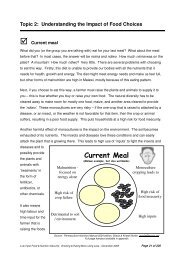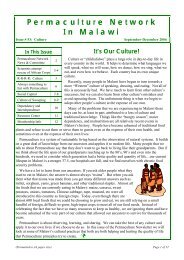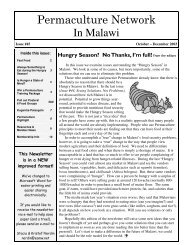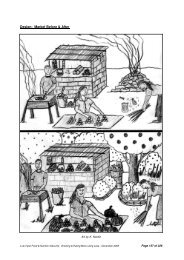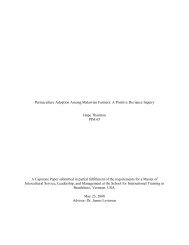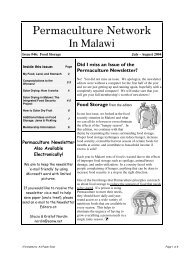Harmonisation of seed laws in Africa.indd - Never Ending Food
Harmonisation of seed laws in Africa.indd - Never Ending Food
Harmonisation of seed laws in Africa.indd - Never Ending Food
You also want an ePaper? Increase the reach of your titles
YUMPU automatically turns print PDFs into web optimized ePapers that Google loves.
GRICULTURE, ENERGY AND LIVELIHOOD SERIES<br />
harvested material; and so-called ‘essentially derived’ varieties and certa<strong>in</strong> other varieties (article 14<br />
(5): e.g. varieties that are essentially derived from the protected variety, varieties that are not clearly<br />
dist<strong>in</strong>guishable from the protected variety, and varieties whose production requires repeated use <strong>of</strong><br />
the protected variety).<br />
Effectively, the extensive scope <strong>of</strong> breeders’ rights could restrict others from freely us<strong>in</strong>g protected<br />
varieties for research and breed<strong>in</strong>g purposes and limits development <strong>of</strong> new varieties from the<br />
protected varieties. Under UPOV 1978, Article 5(3) allowed the use <strong>of</strong> a protected variety as an <strong>in</strong>itial<br />
source <strong>of</strong> variation for the purposes <strong>of</strong> creat<strong>in</strong>g other varieties, or for the market<strong>in</strong>g <strong>of</strong> such varieties.<br />
Breeder authorisation was only required <strong>in</strong> cases <strong>of</strong> repeated use <strong>of</strong> the protected variety. However,<br />
this option is not available under UPOV 1991.<br />
The DUS or DUSN requirements<br />
To qualify for protection under the UPOV 1991 system, a plant variety must be dist<strong>in</strong>ct, uniform,<br />
stable (DUS) and novel (DUSN criteria). These requirements are significant <strong>in</strong> that they specify which<br />
plant varieties can be protected by PVP and also def<strong>in</strong>e what actually qualifies as a plant variety.<br />
Standardisation is thus encouraged /legalised and hence does not acknowledge or accommodate<br />
more genetically diverse plant varieties, traditional varieties or cultivated landraces.<br />
UPOV 1991 def<strong>in</strong>es novelty not <strong>in</strong> terms <strong>of</strong> the previous existence or not <strong>of</strong> a variety, but <strong>in</strong> relation<br />
to whether or not it has been commercialised. Further, a variety would satisfy the criterion <strong>of</strong><br />
‘dist<strong>in</strong>ctness’ if the variety is clearly dist<strong>in</strong>guishable from another variety, whose existence is a<br />
matter <strong>of</strong> common knowledge at the time <strong>of</strong> the fil<strong>in</strong>g <strong>of</strong> the application, particularly if it is not<br />
covered by an exist<strong>in</strong>g PVP application (which is subsequently allowed), or was not registered <strong>in</strong> an<br />
<strong>of</strong>ficial register <strong>of</strong> varieties. This criterion has no agronomic value at all. It is irrelevant to farmers<br />
whether or not a variety is dist<strong>in</strong>ct.<br />
The concepts <strong>of</strong> ‘novelty’ and ‘dist<strong>in</strong>ctness’ are narrowly def<strong>in</strong>ed and could lead to the<br />
misappropriation <strong>of</strong> farmers’ varieties, which are <strong>of</strong>ten not commercialised, as well as not registered.<br />
In addition, the requirement <strong>of</strong> uniformity, – <strong>in</strong> any case a relative term – makes it impossible<br />
for farmer breeders to register any new varieties they develop as these varieties are <strong>in</strong>herently<br />
unstable and <strong>in</strong> permanent evolution. The level <strong>of</strong> uniformity is also a threat to food security as an<br />
<strong>in</strong>creas<strong>in</strong>gly narrow genetic base equals genetic vulnerability, mak<strong>in</strong>g crops vulnerable to pests and<br />
climate stress.<br />
Scope <strong>of</strong> species/genera to be protected and time frame for protection<br />
UPOV 1991 has extended the time frame for PVP to 20 years (or 25 years for trees and v<strong>in</strong>es). The<br />
rules on the range <strong>of</strong> species and plant material have been expanded <strong>in</strong> UPOV 1991 to cover varieties<br />
<strong>of</strong> all genera and species. For new members, UPOV 1991 requires the protection <strong>of</strong> at least 15 plant<br />
genera and species and to all plant genera and species after 10 years. There is just no way <strong>Africa</strong>n<br />
countries can comply with these requirements without severely compromis<strong>in</strong>g farmer managed<br />
<strong>seed</strong> systems, genetic diversity and <strong>in</strong>digenous plants, particularly local varieties necessary to ensure<br />
food security.<br />
Allow<strong>in</strong>g for extended protection does not <strong>in</strong> any way benefit farmer managed systems and<br />
<strong>in</strong>novation through these systems. Such protection only benefits a few commercial <strong>seed</strong> breeders,<br />
which are likely to be mult<strong>in</strong>ational companies. It allows such breeders to dom<strong>in</strong>ate <strong>seed</strong> production<br />
and extract royalties from local farmers for the duration <strong>of</strong> protection.<br />
<strong>Harmonisation</strong> <strong>of</strong> <strong>Africa</strong>’s <strong>seed</strong>s <strong>laws</strong>: a recipe for disaster 15



